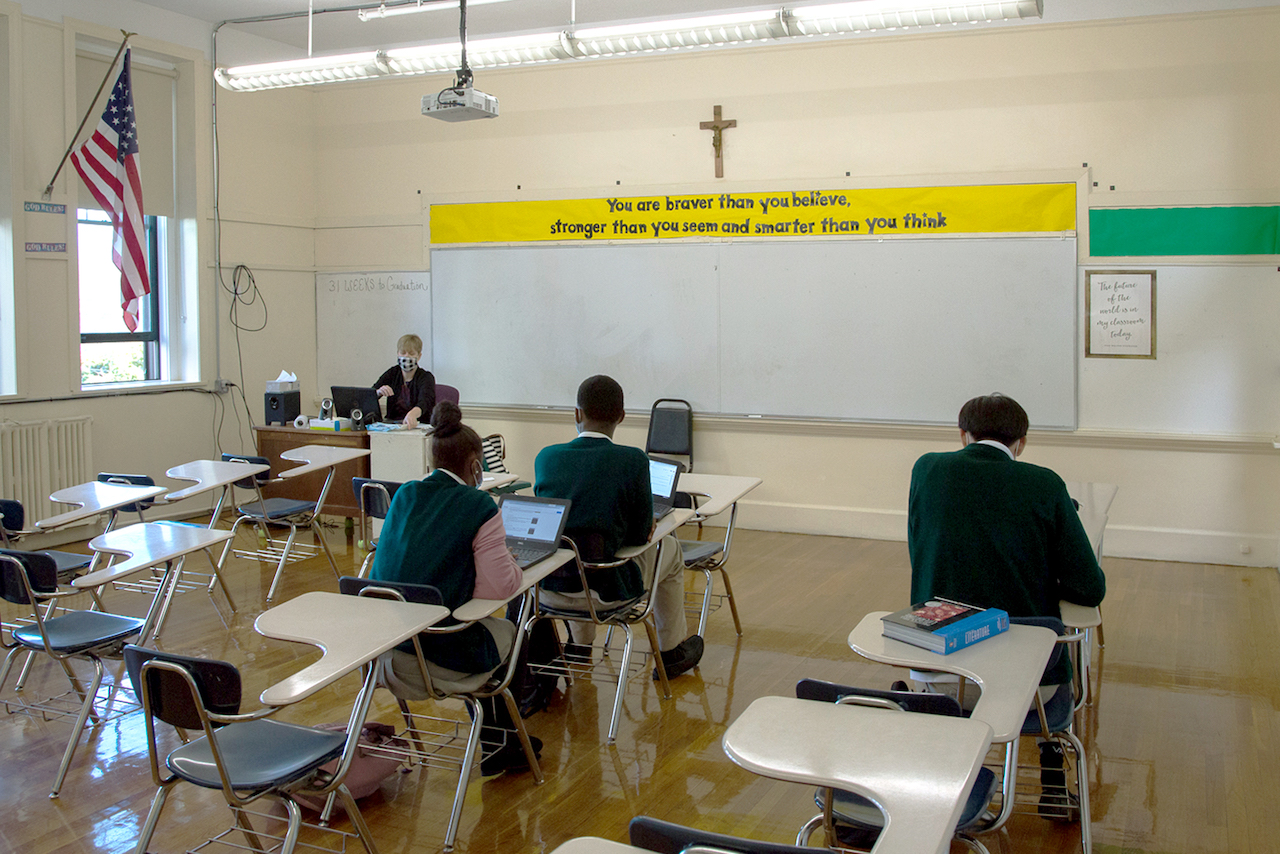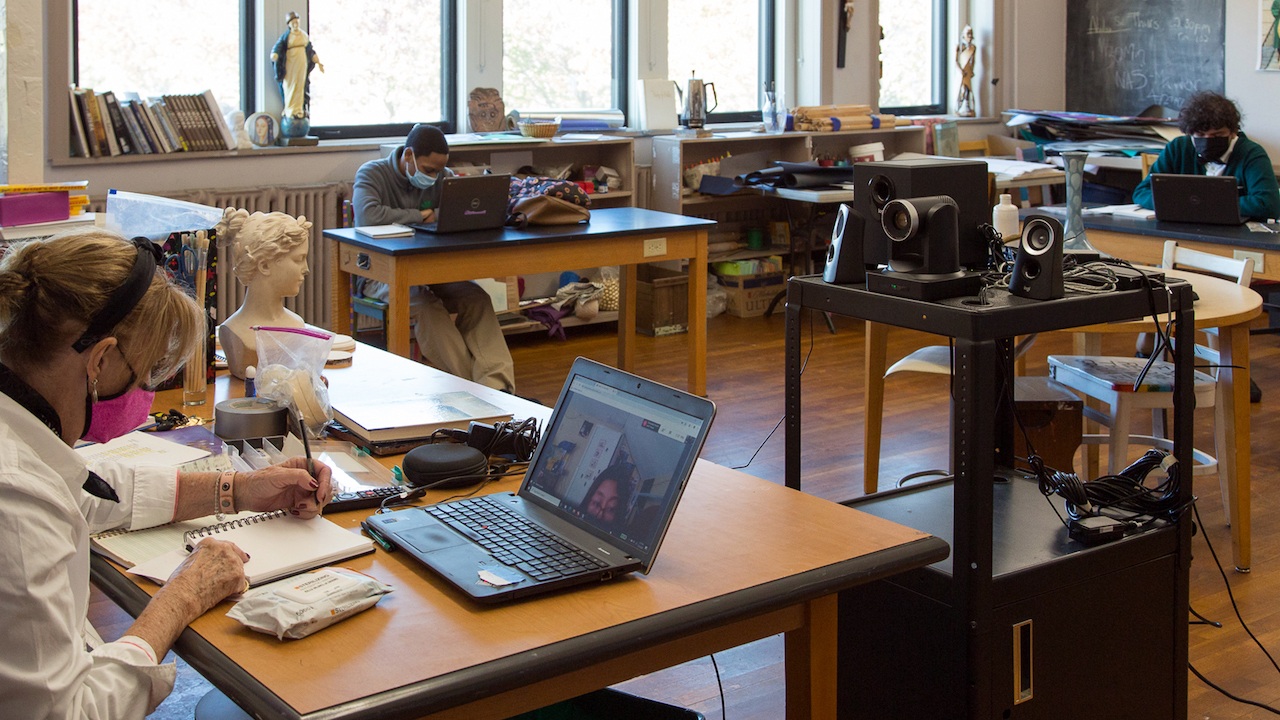St. Patrick Academy in Providence, RI is a small Catholic high school serving inner-city urban youth. Like most schools, classes at St. Patrick went online from mid-March through June, with students attending via Zoom. St. Patrick had limited classroom technology at the time, and while discussing the school’s fall reopening—which would consist of a mix of in-school, at-home (remote), and hybrid attendance models—the planning committee took a closer look at AV. They soon developed a plan to support live video feeds in four classrooms and offer a more authentic learning experience to remote students.
With a modest budget, the planning committee streamlined their AV options and focused on the most pertinent technologies: PTZ cameras to visualize the classroom environment; and USB technologies to extend video, and control signals without excessive wiring.
Related: The Technology Manager's Guide to Distance Learning and Streaming
“We really wanted cameras that were rotatable, rather than having a static camera pointed at the board,” said Mark Luzzi, IT director at St. Patrick. “It was critical to have that PTZ capability so that we could aim them anywhere we want, and really capture that feeling of being part of the classroom.”
The school soon purchased Atlona HDVS-CAM Series PTZ cameras for six classrooms, along with extender kits for wireless HDMI and USB transport to classroom displays. The school also purchased Jabra microphones to capture live lecture audio so students can clearly hear the lessons and student-teacher interaction inside the classroom as it happens.
Engaging Experience
The Atlona cameras are mounted at the back of the classrooms, enabling the widest angle possible. The planning committee selected the AT-HDVS-CAM-HDMI model, which features an HDMI and USB output. The AT-OME-EX-KIT extender kits interact with both outputs for wireless signal transport.
The cameras can be reconfigured in each classroom depending on what the teacher’s needs are for the day. “They can switch the presets to change the camera to point at the desk, at the board, at a particular student, at a podium, or to capture a presentation they are delivering that day,” Luzzi said. “This makes the experience more engaging for the students at home, because they can align the work that they are doing in class with how the teacher and classmates interact while in session.”
Luzzi and his colleague, dean of students and director of athletics Charles Toste, performed the installation of the new systems. All classrooms were equipped with an AT-HDVS-CAM-HDMI camera, a Jabra microphone, and access to the network switch.
“The ports are directly next to the cameras in each classroom, and then we have all the cabling running from the cameras and receiver to the transmitter on each teacher’s desk,” Luzzi said. “We also hardwired a printer in each classroom to a port that is shared with the camera.” Other connections include existing ceiling-mounted projectors in each classroom, along with smartboards in the larger classrooms.
Bruce Daigle, principal at St. Patrick’s, recounted the excitement that followed the procurement and installation. The school held two weeks of training sessions so that the teachers would be familiar with the technology when school began.
“Once the installation was complete, we went straight into learning how to use the systems properly,” he said. “Students also received training so that they understood how to use their laptops in conjunction with the camera systems. What we wanted to ensure was that the technology was ready for use, and that everyone was prepared to use it.”
In addition to the classroom integration, Luzzi and Toste equipped two mobile carts for use in spaces currently not set up for distance learning. Toste uses them during gym class to remote students engaged with physical fitness. “There’s still a way for them to participate and engage even if they’re not doing traditional sports activities,” Luzzi said. “They can still exercise and follow along, and it allows for more interactivity between the teacher and those students.”
Strong Reinforcements
Luzzi said that it was necessary to double the school’s bandwidth due to the increased amount of video traffic on the network, leading to the purchase of a new switch and controller.

“We usually have four of the six cameras active at one time, and at times we have five cameras active,” he said. “We needed to block out other devices that normally connect to the network to prepare for that traffic—things like student cell phones, or devices that belong to the parishioners that come into the building.”
Students both onsite and off connect via school-supplied Chromebooks, with teachers using a combination of Chromebook, Dell, Lenovo, and Mac laptops. The AV traffic runs on the school’s main network, with several devices (such as printers) connected via VLAN.
All four classrooms are outfitted with 100-foot Cat-6 cables, in addition to high-speed HDMI cabling. “The cameras support a higher resolution than we previously anticipated having access to, and although we’re not running at full 1080p, we now have the appropriate cabling,” Luzzi said. The cameras currently run at 720p.
One D-Link controller with four separate extensions sits on each floor of the two-story building, plus a “parent” NETGEAR controller—essentially, a controller for the controller. There are also four 32-port D-Link hubs per floor capable of handling up to 1Gb.
Luzzi noted that the quality of the distance learning experience delivered by St. Patrick’s today far exceeds what the school was capable of during the spring lockdown.
“The kids at home can actually read the board as the teacher posts content, and PowerPoints can be viewed through the share feature on a Google Meet or Zoom call,” he said. “The camera can be pointed at the board, and it’s identical, visually. The quality is very rich in terms of capturing even the smallest of details.”
Clear Views
To streamline the user experience in the classroom, Luzzi relied on the preset functionality that is integrated into the AT-HDVS-CAM-HDMI cameras. “The presets were designed to be uniform in each classroom so that if a teacher is moving between classrooms, the exact same settings can be applied,” Luzzi said.
These presets are configured to provide shots of the whiteboard or smartboard, the teacher’s desk, a wide angle of the entire classroom, or shots of secondary display boards and projections. “Additionally, they can use the directional arrows on their remote control to pan and tilt the camera. That allows them to focus in on something significant as needed.”
And, because the positioning of each camera enables a 250-to-280 degree viewing angle—and their pan/tilt feature gives teachers the option of focusing in on individual students, for example—Luzzi believes that remote students feel more connected to what’s taking place in the classroom itself.
“For students at home, it’s nice to see those different angles depending on what the teacher is doing—it feels like you’re in the classroom without physically being there,” he said. “This allows for the teacher to show the students much more than they previously could.”
The cameras connect to the receivers via USB, and the transmitters (located on the teachers’ desks) are equipped with a USB cable for laptop connection. In addition to HDMI and USB, the AT-OME-EX-KIT extender kits carry Ethernet, power and control.
The USB-enabled Jabra speaker/microphones deliver what Luzzi describes as a more authentic audio experience for students participating remotely.
“We’re using the Jabras because it allows the students at home to hear the students in the classroom,” he said. Placed on the teacher’s desk, the Jabra units pick up audio all the way to the back of the classroom.
Daigle said that the St. Patrick Academy faculty reports that the cameras have changed the dynamic of remote learning.
“The camera systems give them previously unseen flexibility in the classroom, and we hear consistent praise about how the remote-control functionality makes it easy to adjust camera angles in ways that are meaningful to each lesson,” Daigle said. “And the kids like this a lot better than Zoom because they can see and hear everything that’s going on in the classroom. It has made it much easier for them to engage in the learning process.”
